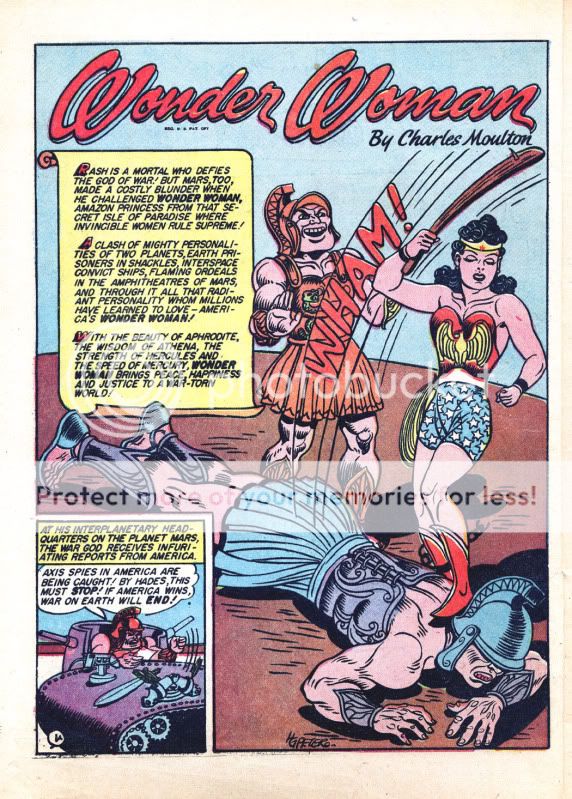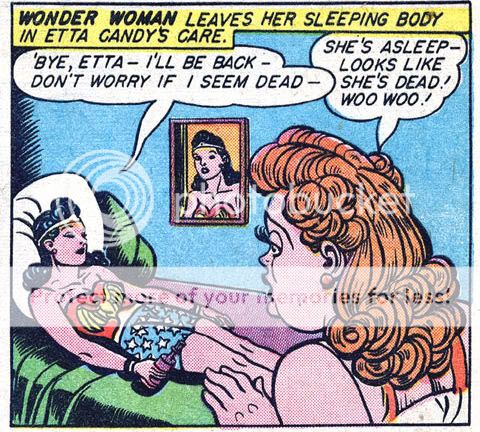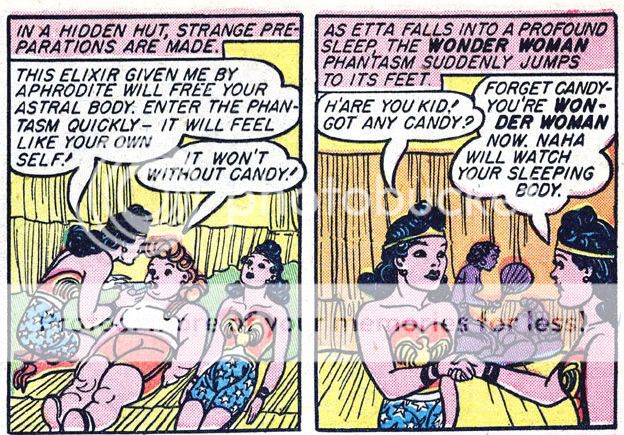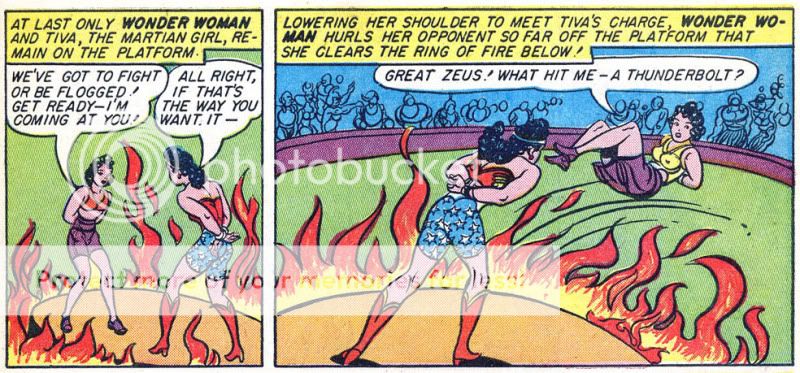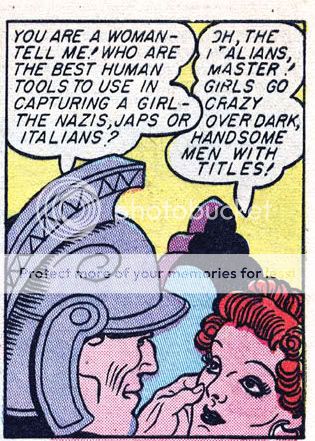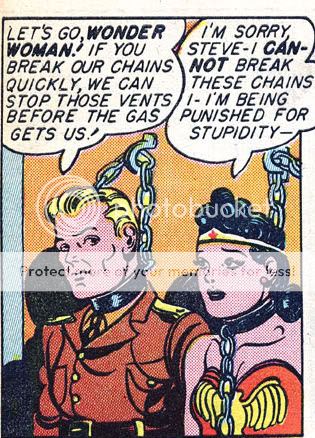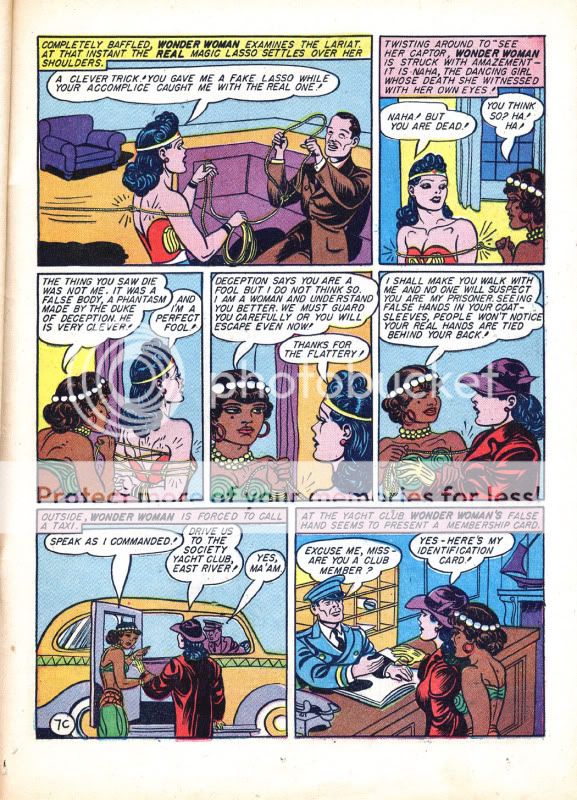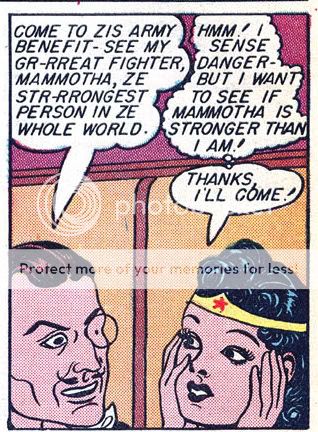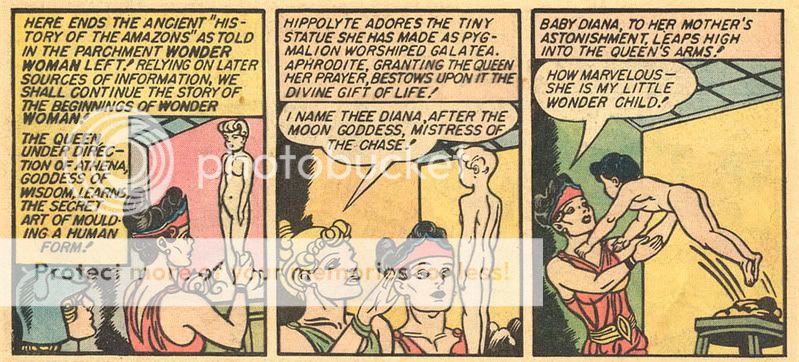So it occurred to me as I started to work on blogging my way through the third Marston Wonder Woman that I wasn’t really sure when to stop. That is, what was the last issue of WW that Marston wrote? I know he died in 1947…but I haven’t been able to find anyone to tell me the number of his final issue. The problem is compounded by the fact that I think DC kept labeling the books as Marston-penned for some time after his death. So…anyone out there know which was his final effort?
_____________
Anyway, while fruitlessly trying to determine when I could lay this burden down, I did find some juicy Marston quotes:
“The only hope for peace is to teach people who are full of pep and unbound force to enjoy being bound … Only when the control of self by others is more pleasant than the unbound assertion of self in human relationships can we hope for a stable, peaceful human society. … Giving to others, being controlled by them, submitting to other people cannot possibly be enjoyable without a strong erotic element”.
“Tell me anybody’s preference in story strips and I’ll tell you his subconscious desires…Superman and the army of male comics characters who resemble him satisfy the simple desire to be stronger and more powerful than anybody else. Wonder Woman satisfies the subconscious, elaborately disguised desire of males to be mastered by a woman who loves them.”
“I am one of those odd, perhaps unfortunate men who derive an extreme erotic pleasure from the mere thought of a beautiful girl chained or bound…Have you the same interest in bonds and fetters that I have?”
That last one was apparently from a letter Marston wrote to William Gaines. To which Gaines replied (and this is a direct quote) — “Oy.”
I also found out that Marston apparently hand-picked Harry G. Peter over the objections of his editor, Sheldon Mayer. Marston liked Peter’s mix of innocence and sensuality, it sounds like. Mayer felt Peter was too old-fashioned. Score another one for Marston.
_______________
Enough shilly-shallying. Let’s see that cover to #3:
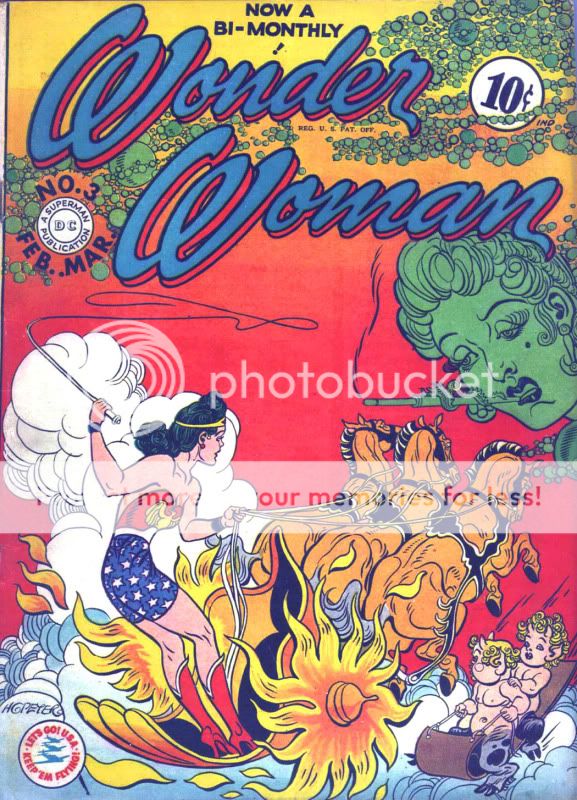
I think that’s the best cover so far, actually. Completely insane juxtaposition of fantasy chariot and big honking disembodied head. And the colors! Saturated orange sky, gaudy green bubbles — Wonder Woman’s ridiculous red and blue suit is rendered relatively sedate in comparison. (Who did the color on these books, I wonder? Does anyone know?) That giant curvy eyebrow on the floating face is worth the price of admission alone, I think. Or the dragon-entwined cigarette holder; or the sledding cherubs, Or the incredibly expressive, frilly lines making up the horse’s leg.
Did I mention that I love Peter?
Also, notice that WW apparently went to bi-monthly with this issue. The book must have been selling well. Coming out six times a year, that means Peter must have been banging out about a page a day for just this title alone, plus what I presume was a comparable amount of work for Sensation Comics. So…two pages a day? That’s a pretty serious workload.
As far as the plot goes, this issue is devoted to a battle against, and the ultimate conversion of Nazi agent Baroness Paula von Gunther. Wikipedia informs me that the Baroness was knocking around for a while before this issue, showing up on several occasions in Sensation Comics, and on one occasion plotting to monopolize the American milk supply so that U.S. citizens would have weak bones and be unable to defeat Hitler’s stronger-boned armies. She also showed up in a fairly unmemorable adventure in Wonder Woman #1, where she appears to have been drowned. But (as is the way with the super-villains) it didn’t take, and she’s back now.
The first chapter is easily the best. Paradise Island seems always to fire Marston’s, um, imagination. This was a Christmas issue, I think…but of course, the Amazons don’t celebrate Christmas, because they’re pagans. Instead, they celebrate a solstice festival called Diana’s Day. Diana’s Day rituals include gift giving…and, to no one’s surprise, also masquerade and bondage. Oh, yes, and dressing up as deer to be hunted, hog-tied, and ritually fake-eaten.
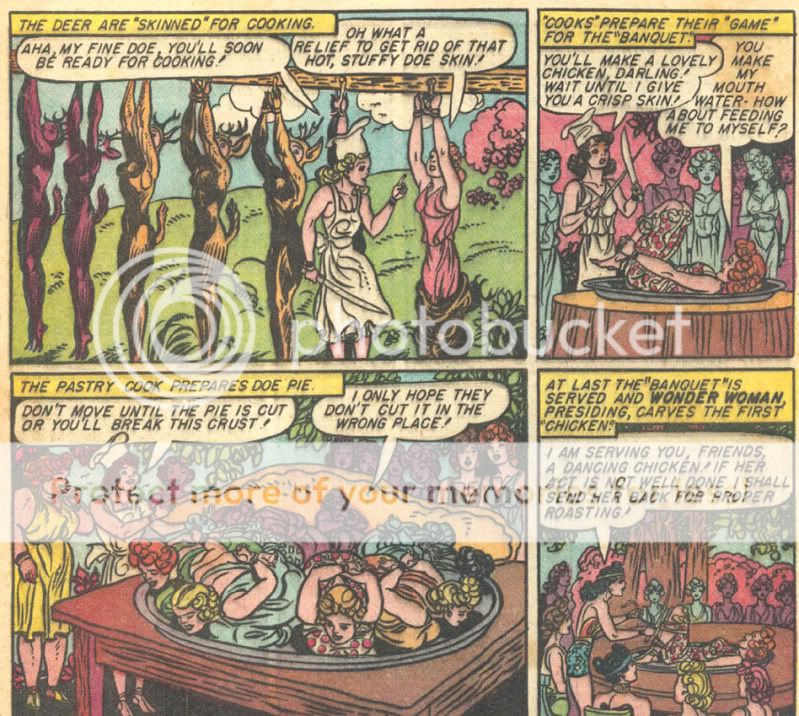
“You make my mouth water. How about feeding me to myself?” Not really much to add to that.
One of the things this chapter really brought home to me was the extent to which Paradise Island functions as a kind of gay utopia; defined by some clueless straight guy as “an imaginary future in which gender, sexuality, and identity are fluid and in which pleasure is unregulated by either external or internal censors. It’s a place where taboos dissolve and sublimation vanishes; every relationship is erotic, every action sensual.” Paradise Island is literally paradise; it’s prelapsarian. The knowledge of good and evil, of shame, is suspended. The women on Paradise Island don’t behave like grown women; they behave like polymorphously perverse children. They love gifts; they throw themselves bodily into play and pretend; they have no particular inhibitions.
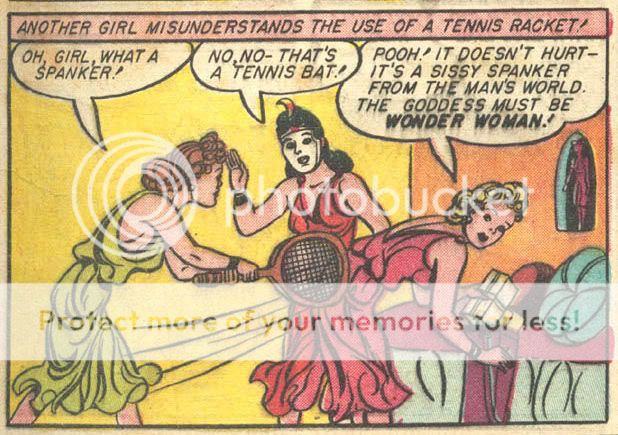
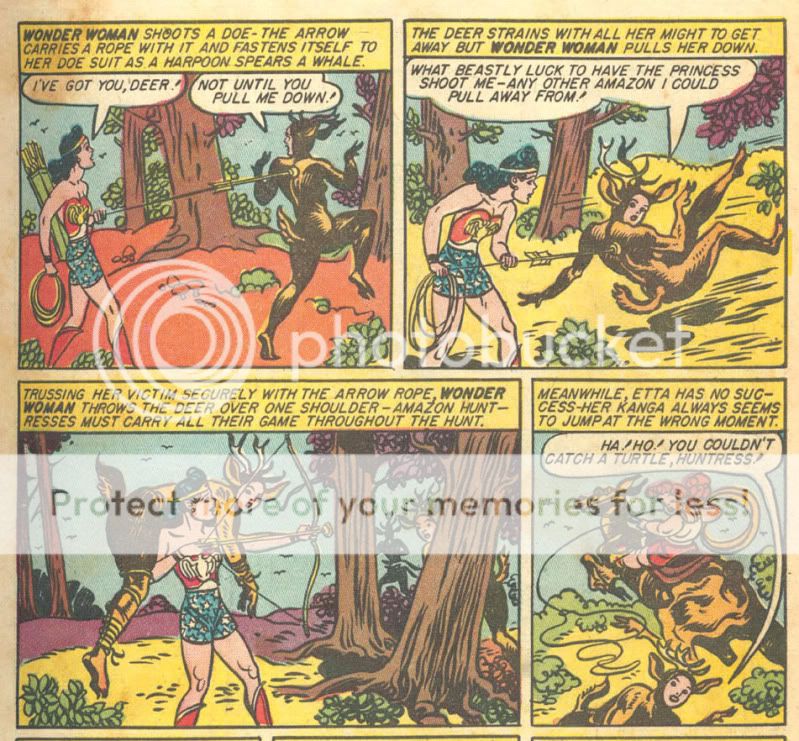
They’re innocents — but innocence here is charged with eroticism. They haven’t fallen, so they don’t perceive sex as sin, which means that anything goes (or is, at least, implied, this being an all-ages title.)
In particular, not having fallen means that the incest taboo is repealed. Radical feminist Shulamith Firestone (writing some time after Marston) argued that without the incest taboo
adults might return within a few generations to a more natural “polymorphously perverse” sexuality, the concentration on genital sex and orgasmic pleasure giving way to total physical/emotional relationships that included that. Relations with children would include as much genital sex as the child was capable of…. Adult/child and homosexual sex taboos would disappear, as well as nonsexual friendships…. All close relationships would include the physical, our concept of exclusive physical partnerships (monogamy) disappearing from our psychic structure as well as the construct of a Partner Ideal.
For Firestone, getting rid of the patriarchal law would eliminate hierarchy; prejudice and authority would dissolve in a warm polymorphous rush. Marston’s vision is analagous, even if he doesn’t exactly see the law disappearing. Rather, he wants the law of the father replaced with the law of the mother; force replaced with “loving obedience” (a term I’m pretty sure I’ve seen him use a couple of times.) Aphrodite’s rule (and by extension Hippolyta’s rule) over Paradise Island is a mother’s rule. But more than that, *all* the relationships on Paradise Island are essentially eroticized mother/daughter relationships. Wonder Woman sitting in a compromising position on Hippolyta’s lap is the blueprint for how all the Amazon’s relate to each other; maternal sentiment bleeding over into eroticism.
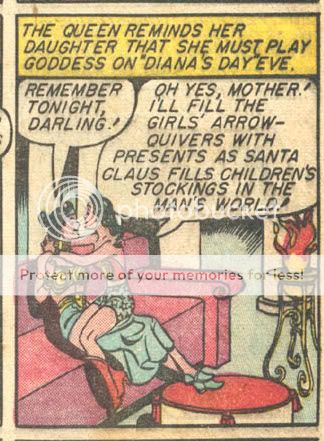
Everybody gets to be lovingly obedient and to enforce loving obedience. It’s all daughters playing at being mothers playing at being daughters, sending each other to their rooms — or, you know, to their bonds. Or whatever.
The charged mother worship here is analagous to that in Tabico’s awesomely squicky story “Adaptation”, in which an alien female insect implants mind-controlling larvae in human hosts, precipitating an escalating mother-love apocalypse of incestuous, cross-species prelapsarian obedience and abjection. (The story is both extremely X-rated and viscerally disgusting…we’re talking sex with bugs here, people. Explicit sex with bugs. So, don’t say I didn’t warn you.)
Update: Tabico’s not a widely known author, but I explain at length why you should care about her (or why I do, anyway) at the end of this essay.
And, as in Tabico’s story, when mother love dissolves the Law — you don’t have the law. Babies don’t worry about good vs. evil; they think about what feels right and what they need. Tabico is rooting for the insects…and while Marston isn’t exactly rooting for the Nazis, I think it’s safe to say that he isn’t exactly unsympathetic to the Baroness either.
In fact, in terms of the erotic economy of this first story, the Baroness and her minions serve exactly the same funciton as the Amazons themselves. According to the plot, the Baroness has sent one of her slaves, Keela, to Paradise Island to cause mischief. Keela infiltrates the Amazons, ties up Etta Candy (who’s visiting for Diana’s Day) and steals Hippolyta’s girdle, which makes its wearer invulnerable. This allows her to wrestle with and defeat Wonder Woman.
The point here is that Keela acts basically exactly like the Amazons she is supposedly infiltrating. That is, she plays the same bondage games in much the same way:
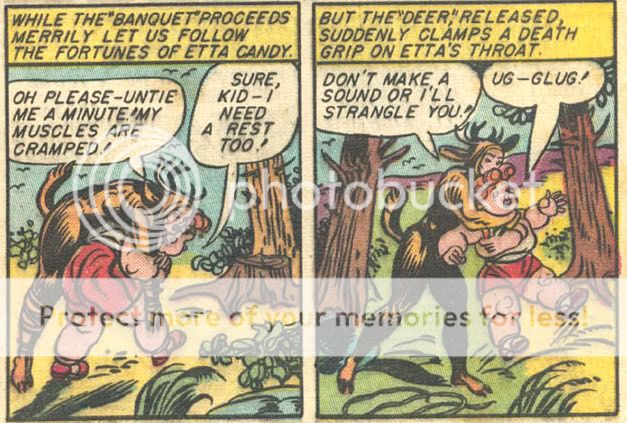
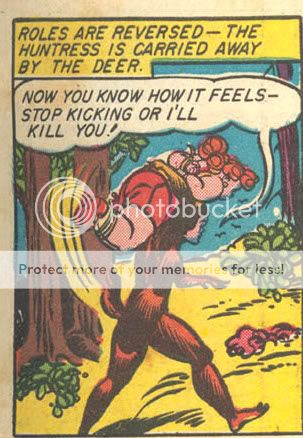
In theory, of course, the Amazons are “just playing” while Keela is in earnest. But surely, the extra earnestness is just a way to increase the erotic charge — and a way, moreover, to put Wonder Woman in a position of submission as well as in a position of dominance. The theft of the girdle gives Keel the power of the mother, who overpowers WW. And then, inevitably, Etta and WW come right back and overpower and control her.
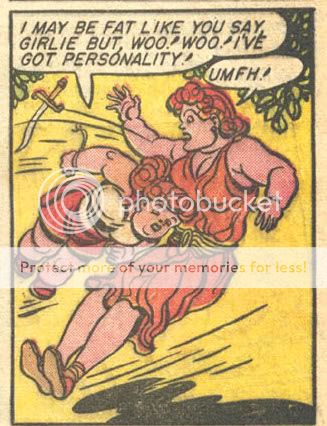
Etta’s fat, as she says, but she gets to participate in the orally erotic mother/daughter back and forth too…as does even Paul von Gunther herself, who the Amazons capture and imprison at the end of the story…only to let her escape immediately. One suspects that they did it on purpose; the play’s the thing, after all, and a mother tied up is no fun unless she can come right back and tie you up as well.
In any case, in the second story in the comic, the Baroness is free…which gives WW the chance to interrogate her slaves using a Brain Detector (a magically more efficient version of the lie detector machines Marston helped develop.) You’d think WW would just use her lasso to command them to tell her what they know…but obviously the machine is fun too…pretty girls hooked up to wires and forced to confess…oh, yes, that’s quite nice….

Ahem.
Oh, by the by, the Baroness’ slaves not only do everything she commands, but they also refuse to be taken out of their chains because they just love being dominated so much. (The Amazons, of course, also wear their bracelets as a symbol of subservience. But they are subservient to a good mother, you see, while the Baroness’ slaves are subservient to a bad mother. It’s much different. No, really.)
Anyway, there’s also a bunch of hoo ha with the Baroness turning various things invisible with some kind of ray (Marston had a thing for invisibility too…and no, I don’t know what was up with that.) Eventually we learn that the Baroness has corrupted Steve Trevor and turned him into a slave as well, which is very broadminded of her, since she seems to generally prefer female thralls.
(One of the ways that WW figures out that Steve is not quite right, incidentally, is that he starts to make eyes at Diana Prince and totally ignores Wonder Woman. I just wanted to point out in passing that the whole love triangle thing with Steve-Diana-WW has never yet seemed anything but tacked on. Diana never actually seems put out, WW and Steve seem completely an item; the whole Diana identity seems more like a way to further humiliate/mock Steve than an actual excuse for melodrama. Don’t get me wrong; it’s kind of fun as an excuse to mock Steve…it just seems very much a leftover from somebody else’s concept. Basically, I think the double-identity thing is a very natural metaphor for masculine identity, but doesn’t really have as much resonance for female identity. Or, at least, it probably could have resonance in a story about women, but Marston wasn’t sufficiently interested in it, it doesn’t seem, to move it away from the Clark Kent/Superman roots in any very interesting way.)
So, to free Steve, WW lets herself be captured by the Baroness to try to figure out how she puts the whammy on her slaves. And she discovers that she does it the good, old-fashioned motherly way — with imprinting.
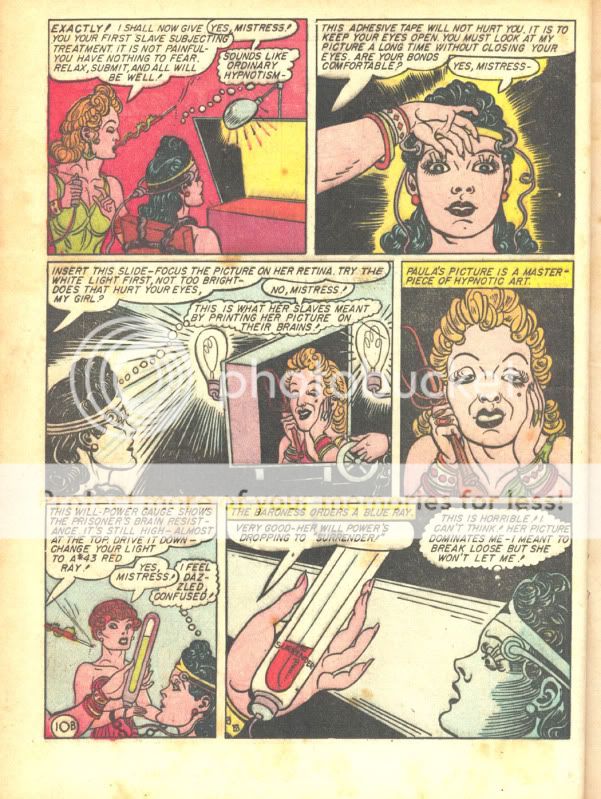
Evil hypnotic art. That’s probably how Wertham saw comics, I guess.
Meanwhile, Steve gets all masculine on Etta:
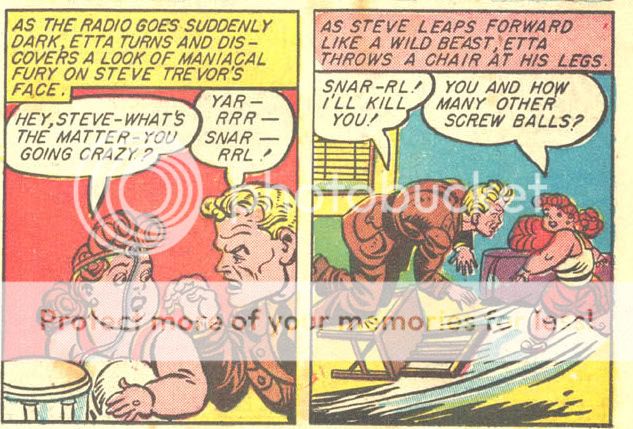
But Etta, through the imporbable exigencies of plot, has WW’s magic lasso, and so comes out on top, forcing Steve to take her to his leader:
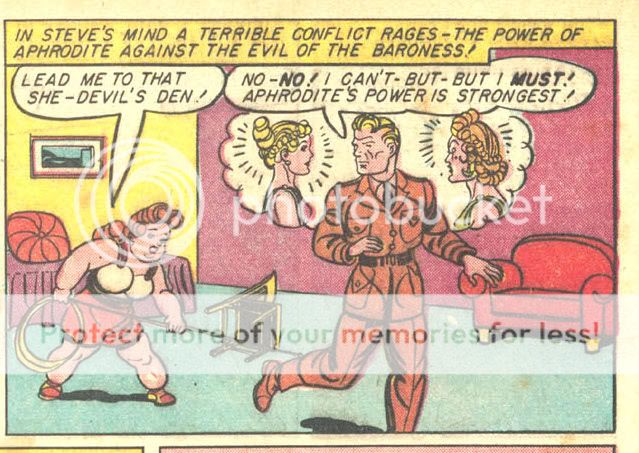
I love that picture, with the dueling mother-heads. It’s so manga…and Etta over to the side is even kind of hyper-deformed. Did Tezuka ever see this stuff? Probably not…though you’d think he’d appreciate it, what with all the bizarre gender goings on.
Seeing WW bowed and broken by the mind control snaps Steve out of his trance…though Etta actually does most of the fighting.
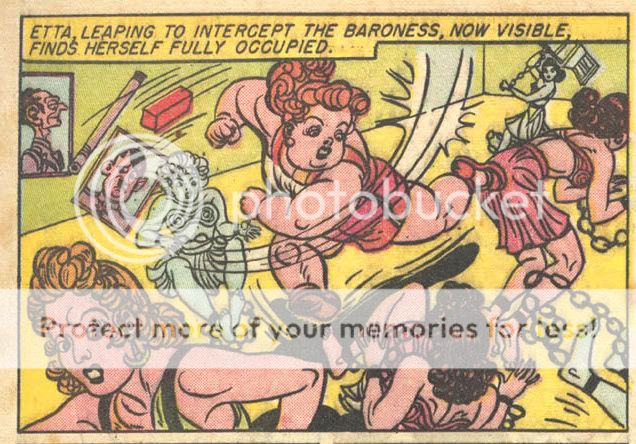
So the purveyor of perverted mother love is defeated…though again, one wonders why her particular brand of perverted mother love is necessarily evil, while everybody else’s perverted mother love seems perfectly okay. When the Baroness is shipped back to Paradise Island, we get several more eyefulls of her devoted slaves, and…well, let’s say there’s a certain amount of cognitive dissonance:
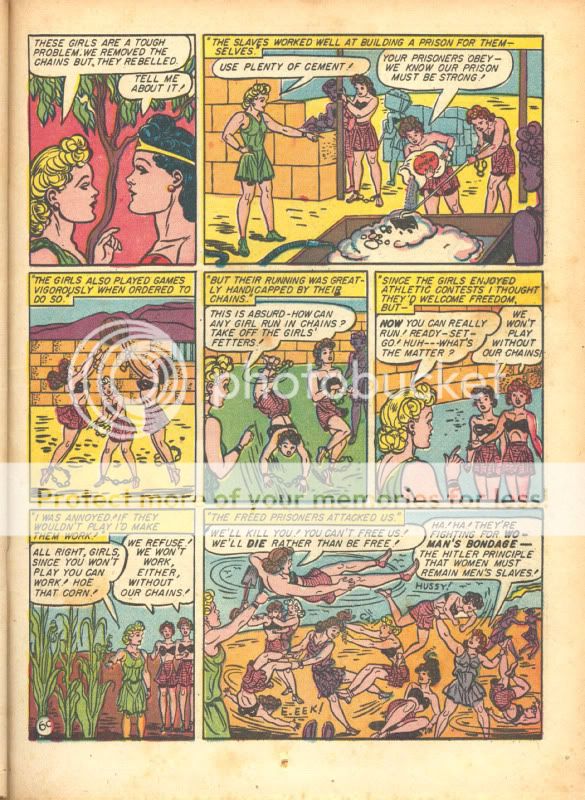
The slaves love building their prison and wearing their chains; they won’t even take them off to play sports. When the chains are removed, they become violent, demanding that they be reinstated. In the final panel, one of the Amazon’s says that the slaves are fighitng for “women’s bondage — the Hitler principle that women must remain men’s slaves!” Oookay…but if it’s an evil principle, why are y’all so enthusiastic about fetishizing it? The girls are all dressed in short, short skirts and bikini tops; they seem happy, and even willing to, as Marston put it, exercise vigorously. And that last panel, which is supposed to show their violence, looks, more like a dance or (with the typical girl fight shouts of “eek!” and “hussy!”) like a pillow fight. Indeed, with the careful choreography, the colorful, frilly, fabric, and bare skin, it’s not that different from Peter’s drawing of the Diana day rituals — maybe slightly more energetic, but certainly not dangerous or even mildly disturbing, in the way that, say, Steve’s animalistic attack on Etta is.
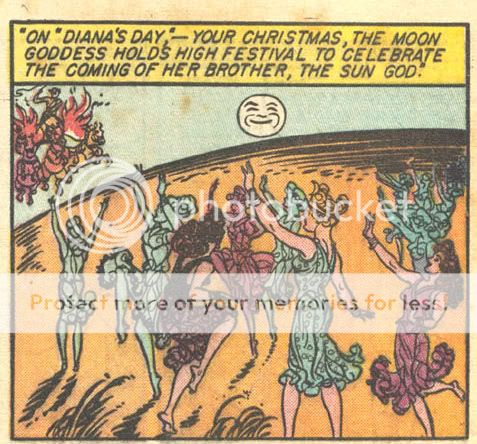
That girl in the center there, for example, has she been thrown to the ground, or is her hair teased up for some kind of windswept photo-shoot look?
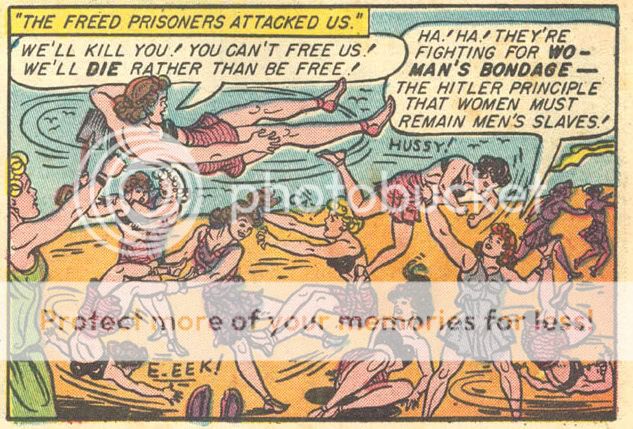
And, indeed, despite all the Hitler principle talk, Marston quickly backtracks. In one panel WW is arguing that the love of slavery is all about women’s false consciousness…and in the next, she’s proscribing, not feminism or equality, but a more benevolent slavery to a good woman (not to a bad woman or to a master.)
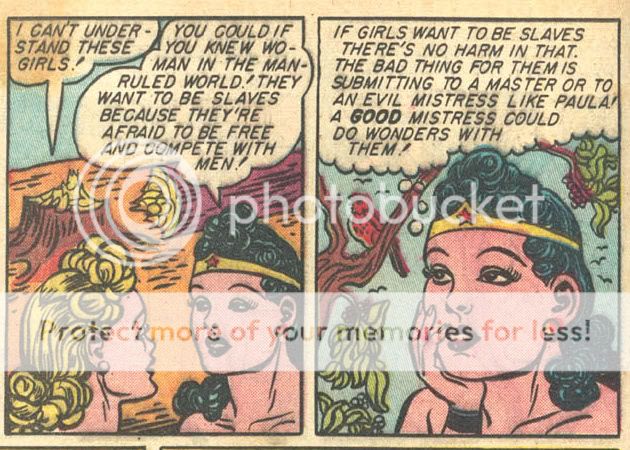
So, of course, to release the prisoners into better living through submission, WW and her sidekick Mala set up some B&D roleplaying, the upshot of which is that the slaves transfer their allegiance to Mala. Mala at first says she doesn’t want slaves…but then she says, well, okay, she’ll have strong, independent slaves, who don’t wear their chains while they’re exercising. Let’s all go swimming, girls!
And, hey, you know what? Good for Marston, really. False consciousness arguments are pretty dreary, not to mention condescending. The whole Tom Frank these-folks-don’t-know-what’s-good-for-them-let’s-educate-them argument…I mean, obviously, propaganda matters, and people are often dumb and women don’t necessarily make good choices any more than men do. But I think it’s generally worth acknowledging that when people acquiesce in oppression or discrimination, they generally have some motivation that can’t be reduced outright to stupidity. It’s not wrong to want someone to take care of you…though obviously you’d want to be careful about the person. Marston’s feminist diagnosis isn’t coherent — it’s a contradictory mess of false consciousness, legitimate emotional goals, fetishization, and pro-lesbian radicalism. That doesn’t make it precisely wrong, though.
Alas, it’s at about this point that the comic starts to go off the rails. Marston is fine when he’s dealing with metaphorical adult-child women and their weird mother bonds. When he tries to write about real mothers and their children, though, we exchange eroticism for sentimentality, which doesn’t tend to work out so well. Right before she was shipped off to paradise island, the Baroness tries to run over a child named Kibby Maxwell who says things like “keen!” and whose name, as I mentioned is “Kibby.” So you can see why the Baroness wants to kill him…but Marston doesn’t see the logic, and instead decides that Paula hates all children because the Nazi’s took her own daughter. Soon enough we’re rescuing children from the evil Nazis, a plotline which even the sight of Etta Candy beating German soldiers with a box of chocolates can’t really redeem.
Update: …though I guess she’s actually just distracting him with the candy on second look, isn’t she?
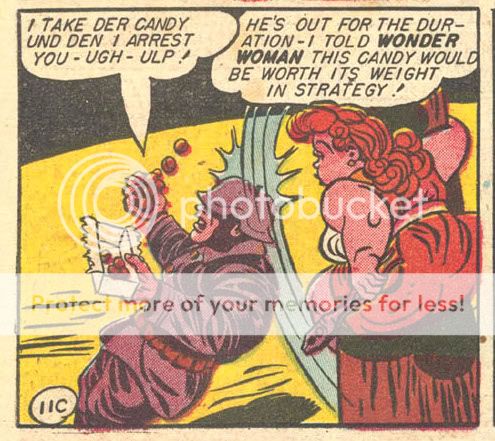
Reunited with her little cherub, Paula becomes all good and sacrificial, plus in the last story we see more of game, insufferable little Kibby. As the emotional content heads for maudlin melodrama, Marston’s plotline shifts towards conventional; instead of crazed stag-masquerades and bizarre invisible rays, we’re stuck with by-the-numbers rescues from burning buildings, tragic facial scarring, and tiresome (though mercifully very brief) courtroom drama. Marston had worked with prisoners and was actually very involved in prison reform, but, unfortunately, that particular interest doesn’t seem to have the same imaginative kick as his bondage obsessions.
The story only really regains its energy on the final page, when (not coincidentally) Marston moves back to Paradise Island and its humid atmosphere of eroticized power dynamics. Paula, in return for all of Wonder Woman’s kindnesses, offers herself as WW’s slave. The last panel shows WW tying herself up in her own lasso and commanding herself “never to use your influence over Paula for your own selfish purposes or to make yourself feel smart” — in other words, to be a good mistress/mother.

It’s a neat moment for several reasons:
First, we’ve actually seen Wonder Woman use her lasso for selfish purposes; in WW #1 she playfully ties up an Amazon doctor and makes her stand on her head. It’s hard to know how much continuity there’s supposed to be here, really, but even in the phrasing (“make yourself smart”) you get the sense of WW as a tomboyish girl who likes a bit of mischief (no, not that kind of mischief…get your mind out of the gutter) …but who has also been affected by the responsibility she’s confronted with, and is trying to do the right thing (and “trying” is the operative word; she’s not certain that giving herself commands will actually work, which is quite true to most people’s experience of parenthood, I think.)
Second, the trope of WW tying herself up in her own lasso is one that actually has gotten a good bit of play down through the years, and it’s worth pointing out that this is the only time I’ve seen it done that it isn’t just offensively stupid. It helps a lot that for Marston the lasso is about dominance and submission, while for most later writers (like Jimenez or whoever wrote League of One) it’s about truth. Tying yourself up in a lasso of truth is an exercise in self-knowledge, which makes it basically about staring at your navel in order to be all pure and wonderful…which is fine if you’re the Buddha, but is tedious, incongruous, and arguably insulting to actual mystics if you then immediately go back to kicking the snot out of your enemies. Tying yourself up in a lasso of submission, though, is about self-control…which is actually something that it makes sense for a warrior to (a) want and (b) struggle with. In fact, now that I think of it, the whole idea of a lasso of control is much, much more logical for an action hero than is a lasso of truth. I wonder if a lasso of control was seen over time as not sufficiently feminine? The lasso of truth makes WW pure instead of powerful; instead of being super-forceful, she’s super-good, which jibes more easily with stereotypical feminine behavior and is (not coincidentally) a hell of a lot less fun.
I mean, if she’d had her original lasso of control, she could have just wrapped Maxwell Lord up and told him *not to do it again*. No dilemma, no angst, no incessant whining. Then she could have, I don’t know, told Supes and Bats to dress up as stags and join her for some fun Diana’s day rituals. Wouldn’t that have been more fulfilling for everybody?
(And just in case you’re wondering, no, I haven’t read that Maxwell Lord storyline, in large part because it sounds insufferable. I’d much rather continue working my way through Marston, thank you very much.)





















